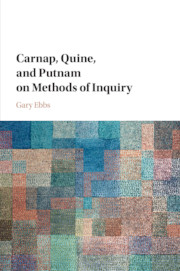47 results
6 - Kripke and Wittgenstein on Rules and Meaning
-
-
- Book:
- Kripke's <i>Wittgenstein on Rules and Private Language</i> at 40
- Published online:
- 22 February 2024
- Print publication:
- 08 February 2024, pp 107-123
-
- Chapter
- Export citation
Chapter 7 - Reading Quine’s Claim that Carnap’s Term “Semantical Rule” Is Meaningless
- from Part III - Carnap and Quine on Logic, Language, and Translation
-
-
- Book:
- The Philosophical Project of Carnap and Quine
- Published online:
- 18 February 2023
- Print publication:
- 23 February 2023, pp 135-153
-
- Chapter
- Export citation
2 - Analyticity
- from Section One - Language, Mind, Epistemology
-
-
- Book:
- The Cambridge History of Philosophy, 1945–2015
- Published online:
- 08 November 2019
- Print publication:
- 21 November 2019, pp 32-48
-
- Chapter
- Export citation
Chapter 10 - Truth and Transtheoretical Terms
- from Part IV - Quine and Putnam
-
- Book:
- Carnap, Quine, and Putnam on Methods of Inquiry
- Published online:
- 22 June 2017
- Print publication:
- 07 June 2017, pp 205-230
-
- Chapter
- Export citation
Part V - Putnam
-
- Book:
- Carnap, Quine, and Putnam on Methods of Inquiry
- Published online:
- 22 June 2017
- Print publication:
- 07 June 2017, pp 231-256
-
- Chapter
- Export citation
Dedication
-
- Book:
- Carnap, Quine, and Putnam on Methods of Inquiry
- Published online:
- 22 June 2017
- Print publication:
- 07 June 2017, pp v-v
-
- Chapter
- Export citation
Dedication
-
- Book:
- Carnap, Quine, and Putnam on Methods of Inquiry
- Published online:
- 22 June 2017
- Print publication:
- 07 June 2017, pp vi-vi
-
- Chapter
- Export citation
Part I - Carnap
-
- Book:
- Carnap, Quine, and Putnam on Methods of Inquiry
- Published online:
- 22 June 2017
- Print publication:
- 07 June 2017, pp 11-54
-
- Chapter
- Export citation
Part II - Carnap and Quine
-
- Book:
- Carnap, Quine, and Putnam on Methods of Inquiry
- Published online:
- 22 June 2017
- Print publication:
- 07 June 2017, pp 55-110
-
- Chapter
- Export citation
Index
-
- Book:
- Carnap, Quine, and Putnam on Methods of Inquiry
- Published online:
- 22 June 2017
- Print publication:
- 07 June 2017, pp 273-278
-
- Chapter
- Export citation
Chapter 7 - Can First-Order Logical Truth Be Defined in Purely Extensional Terms?
- from Part III - Quine
-
- Book:
- Carnap, Quine, and Putnam on Methods of Inquiry
- Published online:
- 22 June 2017
- Print publication:
- 07 June 2017, pp 144-167
-
- Chapter
- Export citation

Carnap, Quine, and Putnam on Methods of Inquiry
-
- Published online:
- 22 June 2017
- Print publication:
- 07 June 2017
Afterword
-
- Book:
- Carnap, Quine, and Putnam on Methods of Inquiry
- Published online:
- 22 June 2017
- Print publication:
- 07 June 2017, pp 257-260
-
- Chapter
- Export citation
Acknowledgments
-
- Book:
- Carnap, Quine, and Putnam on Methods of Inquiry
- Published online:
- 22 June 2017
- Print publication:
- 07 June 2017, pp ix-xii
-
- Chapter
- Export citation
Chapter 5 - Quine Gets the Last Word
- from Part III - Quine
-
- Book:
- Carnap, Quine, and Putnam on Methods of Inquiry
- Published online:
- 22 June 2017
- Print publication:
- 07 June 2017, pp 113-127
-
- Chapter
- Export citation
Copyright page
-
- Book:
- Carnap, Quine, and Putnam on Methods of Inquiry
- Published online:
- 22 June 2017
- Print publication:
- 07 June 2017, pp iv-iv
-
- Chapter
- Export citation
Introduction
-
- Book:
- Carnap, Quine, and Putnam on Methods of Inquiry
- Published online:
- 22 June 2017
- Print publication:
- 07 June 2017, pp 1-10
-
- Chapter
- Export citation
Chapter 2 - Carnap on Ontology
- from Part I - Carnap
-
- Book:
- Carnap, Quine, and Putnam on Methods of Inquiry
- Published online:
- 22 June 2017
- Print publication:
- 07 June 2017, pp 33-54
-
- Chapter
- Export citation
Chapter 3 - Carnap and Quine on Truth by Convention
- from Part II - Carnap and Quine
-
- Book:
- Carnap, Quine, and Putnam on Methods of Inquiry
- Published online:
- 22 June 2017
- Print publication:
- 07 June 2017, pp 57-94
-
- Chapter
- Export citation
Chapter 6 - Reading Quine’s Claim That Definitional Abbreviations Create Synonymies
- from Part III - Quine
-
- Book:
- Carnap, Quine, and Putnam on Methods of Inquiry
- Published online:
- 22 June 2017
- Print publication:
- 07 June 2017, pp 128-143
-
- Chapter
- Export citation



